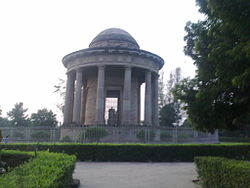Ghazipur
|
Ghazipur गाज़ीपुर غازیپور |
|
|---|---|
| City | |

The Tomb of Lord Cornwallis, Governor-General of British India
|
|
| Location in Uttar Pradesh, India | |
| Coordinates: 25°35′N 83°34′E / 25.58°N 83.57°ECoordinates: 25°35′N 83°34′E / 25.58°N 83.57°E | |
| Country |
|
| State | Uttar Pradesh |
| District | Ghazipur |
| Government | |
| • Type | Municipal Council |
| • Body | Ghazipur Municipal Council |
| • Chairman | Vinod Kumar Agrawal |
| Area | |
| • Total | 20 km2 (8 sq mi) |
| Population (2011) | |
| • Total | 121,136 |
| • Rank | 391 |
| • Density | 6,056/km2 (15,680/sq mi) |
| • Sex ratio | 902 ♀/♂ |
| Demonym(s) | Ghazipuri |
| Languages | |
| • Official | Hindi |
| Time zone | IST (UTC+5:30) |
| PIN | 233001 |
| Telephone code | 91-548 |
| Vehicle registration | UP 61 |
| Website | www |
Ghazipur (Hindi: ग़ाज़ीपुर, Urdu: غازیپور, previously spelled Ghazeepore, Gauspur, and Ghazipour), is a city and municipal corporation in the state of Uttar Pradesh, India. Ghazipur city is the administrative headquarters of the Ghazipur district, one of the four districts that form the Varanasi division of Uttar Pradesh. The city of Ghazipur also constitutes one of the five distinct tehsils, or subdivisions, of the Ghazipur district.
Ghazipur is well known for its opium factory, established by the British East India Company in 1820 and still the biggest legal opium factory in the world, producing the drug for the global pharmaceutical industry.
Sights in the city include several monuments built by Nawab Shaikh Abdulla, or Abdullah Khan, a governor of Ghazipur during the Mughal Empire in the eighteenth century, and his son. These include the palace known as Chihal Satun, or "forty pillars", which retains a very impressive gateway although the palace is in ruins, and the large garden with a tank and a tomb called the Nawab-ki-Chahar-diwari. The mosque near this tomb was probably originally a Hindu building. The road that starts at the Nawab-ki-Chahar-diwari tomb and runs past the mosque leads, after 10 km, to a matha devoted to Pavhari Baba. The tank and tomb of Pahar Khan, faujdar of the city in 1580, and the plain but ancient tombs of the founder, Masud, and his son are also in Ghazipur, as is the tomb of Lord Cornwallis, one of the major figures of Indian and British history. Cornwallis is famous for his role in the American Revolutionary War, and then for his time as Governor-General of India, being said to have laid the true foundation of British rule. He was later Lord Lieutenant of Ireland, there suppressing the 1798 Rebellion and establishing the Act of Union. He died in Ghazipur in 1805, soon after his returning to India for his second appointment as Governor-General. His tomb, overlooking the Ganges, is a heavy dome supported on 12 Doric columns above a cenotaph carved by John Flaxman. The remains of an ancient mud fort also overlook the river, while there are many beautiful or impressive ghats leading to the Ganges, the oldest of which is the ChitNath Ghat.
...
Wikipedia

